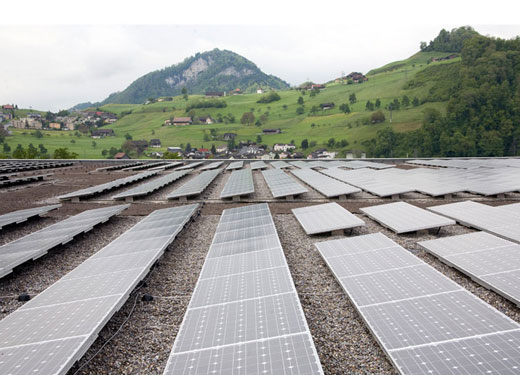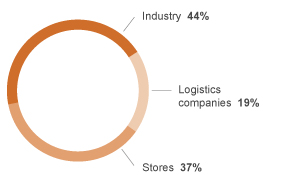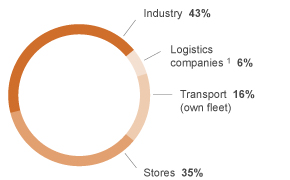
Climate Protection enters the next Phase
Over ten years, Migros achieved CO2 reductions* of about one quarter by implementing comprehensive measures. As such, it hugely exceeded its energy efficiency and climate protection targets by 2010. The retailer aims to further reduce its greenhouse gas emissions in the future.
Saving energy and protecting the climate have a long tradition at Migros. More than 30 years ago, the retailer started to systematically reduce its oil consumption. Until today, it has consistently expanded its commitment to a sustainable handling of energy and the reduction of greenhouse gas emissions in all operational processes. Although Migros's overall energy consumption has hardly changed in recent years, it has nevertheless dropped in relation to sales. Migros has reduced its heat consumption very significantly: the sales area has increased since 1990 by 68 per cent, while heat consumption has been reduced over the same period by 40 per cent. Specific electricity consumption has also been reduced significantly. Last autumn Migros received the Energy Management Award 2010 from the International EHI Retail Institute for these long-standing efforts.
Charts on energy consumption
Share of business units in total energy consumption 2010
2010 CO2 targets hugely exceeded
Since 2002, Migros has been cooperating with the Business Energy Agency (EnAW). Together, they created target agreements, approved by the Swiss Federation, on increasing energy efficiency and reducing CO2 emissions. To implement the agreements, Migros relies, in particular, on energy-efficient systems, heat recovery and waste heat utilisation, as well as the Minergie standard for buildings ((link to buildings/branches)). In addition to working with EnAW, in 2008 Migros focused on climate protection and joined the WWF Climate Group. As such, the retailer implemented an annual measures plan, which includes an energy-saving range and increased communication, as well as operational energy-saving projects. The original target of the agreement with EnAW was to achieve CO2 reductions* of 16 per cent by the end of 2010 compared with the reference year of 2000. Migros greatly exceeded this target and achieved CO2 reductions of 27% by this date. The 27% reduction target set by 2010 has therefore already been achieved. The efforts to achieve CO2 reductions will continue in the future.
*The CO2 emissions reduction is based on the CO2 intensity of combustibles and fuels. This is a specific key figure of the Energy Agency of Economy EnAW and is calculated from the ratio between the real CO2 development and an uninfluenced CO2 development without CO2 reduction measures.
Charts on CO2 target agreements
Generating solar power
With the new 2010+ Power Efficiency Initiative, in which all operations defined new, individual savings targets, Migros aims to further improve its energy balance. But the retailer does not aim to simply use power efficiently, it also wants to promote its sustainable generation. This is why it is Switzerland's biggest consumer of «nature-made» power (nature-made star and basic), i.e. electricity from renewable sources. Migros is also committed to a climate-protection energy supply and operates its own solar power plants or provides roofs for such. At the end of 2010, 15 photovoltaic plants had been installed on Migros buildings, the biggest being in Central Switzerland: on the roof of the Länderpark in Stans, which was reopened in 2010, 4'200 square metres of solar cells generate green power. Switzerland's second largest photovoltaic plant is on the roof of the operating centre of Migros Vaud. It went on stream in 2009 and won the Swiss Solar Award last year ((link awards)). A further solar highlight was the opening of a plant in efficient thin-layer technology on the carpark roof of the Rheinpark in St. Margrethen.
Promoting renewable energies
In addition to the sun, Migros also uses other renewable power sources. For instance, a wind power plant that the Gossau operating centre installed on its main building last March. Migros is also investing in innovative solutions when it comes to heating. In early 2010 a wood-chip heating system in the Vaud operating centre went on stream; the shopping centres Säntispark (SG) and Westside (BE) also heat with wood chips. Migros also uses groundwater heat pumps. The Gossau operating centre has been using one since last year to generate some 600 megawatt hours per year of energy for heating.
Using natural coolants
Migros not only records its CO2 emissions, but also all emissions of greenhouse gases, i.e. coolant losses. This provides the retailer with a detailed carbon footprint of how greenhouse gas pollution breaks down across its various units. It is remarkable that successful energy efficiency measures have resulted in the biggest greenhouse effect in the branches now coming from coolants. To minimise this effect, Migros relies on natural coolants with a negligible greenhouse gas potential, in branches on carbon dioxide: it has a far smaller impact on the climate than synthetic coolants such as FC and HRC. In the meantime, Migros operates the most CO2 refrigerating systems in Switzerland, and possibly the world, with more than 150 plants.
Charts on greenhouse gas emissions and refrigerating systems
Share of business units in total energy consumption 2010